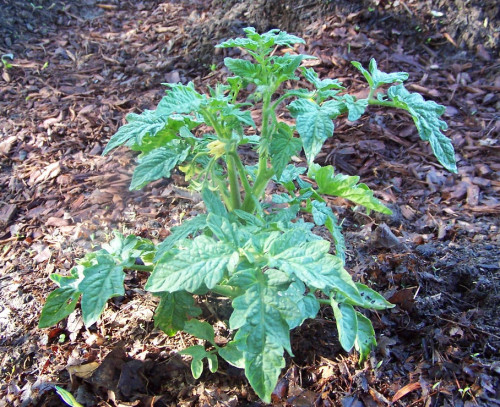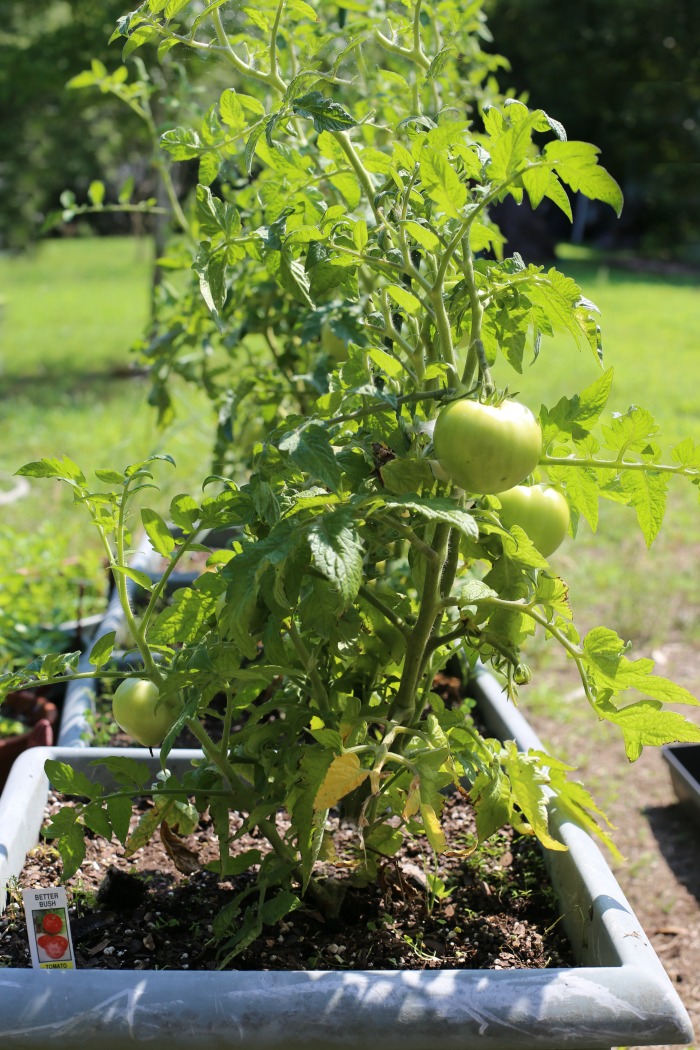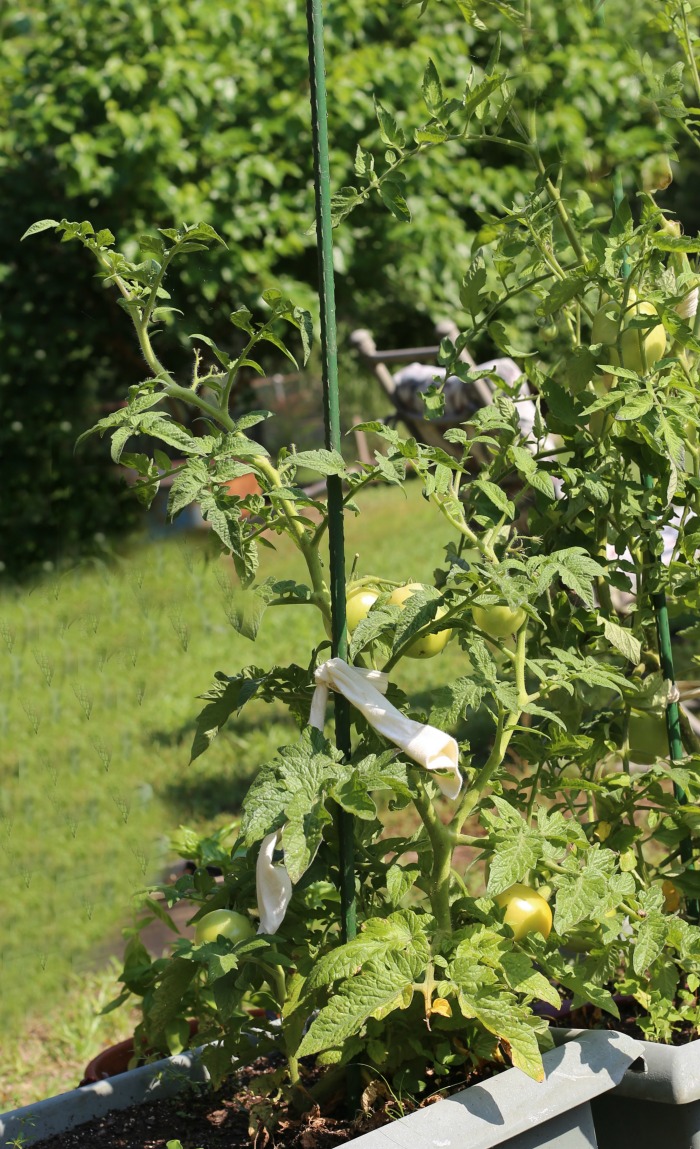Determinate tomato plants are also known as “bush tomatoes”. They are smaller than normal tomato plants and generally need no staking but still produce well.
Nothing tastes quite like a home grown tomato. They are sweet and juicy and so easy to grow.
But they also take a lot of room, so are not so great for those who have small yards and no room to plant the larger varieties.
That is what make a determinate tomato plant perfect for a container, especially if you don’t have room for a whole vegetable garden.

Most beginning gardeners just think of them as tomatoes but there are two distinct types – determinate and indeterminate. The plants have some some similarities (basic light, watering, and fertilizing needs) but also some major differences.
Share this post about determinate tomato plants on Twitter
Why are some tomato plants tall and others more bushy? To find out head to The Gardening Cook to learn the differences between determinate and indeterminate tomato plants.🍅🍅🍅 Click To TweetIndeterminate vs determinate Tomato plant. What is the difference?
The answer to this question is a two part. One that you can understand early on, and the other when the plant bears fruit.
Determinate tomato plants
This type of tomato plant features varieties that grow to a nice compact height. That is why their common name is “bush tomato.”
How tall do determinate tomatoes grow? It varies with the variety but generally a determinate tomato height will top out at about 5 feet or so. Many will grow only to about 3 – 4 feet.
Some dwarf bush tomato varieties will only grow to 24 inches!
Determinate plants will stop growing when the fruit sets on the top bud. All of the fruit on determinate tomatoes ripen at about the same time and usually over a 1- 2 week period.

They require a limited amount of staking for support and are perfectly suited for container planting because of their smaller size. Many gardeners grow them on patios for this reason.
Determinate tomato plant are thought by many gardeners to be more resistant to tomato blossom drop, since they set fruit early. On the other hand, they are less prone to sunscald for the same reason!
Indeterminate Tomato plants
Do you have lots of room in your garden and like a longer growing season? Then Indeterminate tomatoes may be a better choice. This type of tomato gets large and will need staking.
Proper staking will keep leaves away from the ground, and help to prevent all sorts of diseases including those that produce black spots on the leaves.
They can reach heights of up to 12 feet although I have found that mine get to about 6 feet. Indeterminate tomatoes will keep growing and will produce fruit until they are killed by frost in the fall.
Indeterminate tomatoes are less prone to tomato bottom rot, which is caused by a calcium deficiency linked to incorrect watering. They are also more likely to develop tomato leaf curl than determinate varieties.
Take note, though, that indeterminate tomatoes, with their long growing time, can slow down the ripening of the fruit when the temperatures are very hot. Find out my tips for ripening tomatoes on the vine to get through this stage.

This type of tomatoes will bloom, set new fruit and ripen fruit throughout the entire growing season so you will have a longer time to harvest.
Don’t make the gardening mistake that many beginners make with indeterminate tomatoes. They require substantial staking for support which means that you need space to grow them.
But never fear, you can usually identify the type of tomato plant that you have simply by reading the plant label. The word determinate or indeterminate should be clearly labeled on the seed pack or tomato transplant container.
Comparing the two types of tomato plants
Here are pictures that I took of two tomato plants that were planted on the same day, just a few weeks ago. The determinate plant in the first picture is already very bushy and has set some buds for flowers.
The indeterminate plant in the second photo is much more spindly and you can see it has quite a way to go.
As the plants continue to grow, the bushiness of the determinate will continue to develop, as will the more leggy look of the indeterminate type.
Container Gardening for Tomato Plants
Both types of tomatoes can be grown in containers if you don’t have room for a large vegetable garden, but the determinate variety is best suited for this type of gardening.
Bush tomatoes can also grow just fine in a normal vegetable garden bed.
How large should the pot be?
The container size for determinate tomatoes depends, once again on your variety. I have very good luck using 18″ or 24″ pots. The can be staked if I need them to and the size pot gives the roots of the plant plenty of room to grow.
Don’t let the small size of determinate tomato plants fool you into thinking that the fruit will be small.
There is more to determinate tomatoes than just the cherry tomato variety. I am currently growing the “Better Bush” variety which has just set fruit and it is very large.

The tomatoes are huge and I’ll likely get an entire extra season with new plants since we don’t get frost until almost November here in North Carolina.
If you want to grow plants in containers, you will probably want to stick with a few different determinate varieties. They are more well-behaved and better suited to container growing.
Some good determinate tomatoes for containers are:
- Celebrity
- Better Bush
- Early Girl
- Mountain Spring
You can certainly grow indeterminate tomatoes in containers, but you will have to be prepared to be vigilant about staking or caging, as well as pruning the suckers to maintain compact growth.
Tips for Growing Determinate Tomato Plants
In addition to the smaller size, bushy nature and harvesting time, determinate tomato care has a few other steps to get the most out of the plants.
Pruning Tomatoes
It is commonly taught that plants need to be pruned to stay bushy. Some people prune indeterminate tomatoes to keep their size in check, but this can cause the plant to put its energy into producing fruit rather than leaves.
However, never prune the top of a determinate type tomato. You will want all the fruit you can get from these shorter plants and they will stay bushy without needing to prune.
Both types of tomato plants need to have their suckers removed. To properly prune a determinate tomato, pinch all of the suckers that grow from the ground level to the first flower cluster.
Then continue to remove the suckers as they appear at the leaf nodes along the stem.

A sucker is a tiny stem that grows at 45 degrees between the main trunk and stem of a tomato. Pinch these out at the base of the sucker.
This is easiest to do when the sucker is small! Pinching out these suckers will give you a stronger tomato plant.
Staking Tips
Determinate tomatoes keep a compact bushy size so they don’t need cages or staking the way the determinate varieties do. 
I have never used cages for my determinate plants, but sometimes will stake them as they set fruit if the stems have several tomatoes in one place. This supports the stems more than the tomatoes.
The stakes look a bit odd since they are for taller tomatoes but they do the job just fine!
General determinate tomato plant care
The basic care of determinate tomato plants is the same as all tomato plants. For a more complete article on tips and tricks for growing great tomatoes, see this post.
Light
Determinate tomatoes need full sun – at least 6- 8 hours of direct sunlight each day.
Temperature requirements
Plant two weeks after the expected date of the last frost. There is some thought that early planting is better, but I find that if I wait, the later plants will catch up just fine. They like it to be warm before they really start growing well.
Watering Needs
Water frequently for a week or two after transplanting, gradually diminishing frequency and increasing the depth of penetration. After that, thoroughly soak the soil about once a week or more often if the weather is very hot.
Tomato plants should not be sprinkled late in the day. Water deeply to encourage deep root growth rather than a little bit more often.
Mulching
Even in containers, mulching will help to control weeds and moisture levels. Cover the soil around the plants with a plastic or organic mulch to maintain uniform moisture levels.
I use grass and leaf mulch for mine. Don’t go too close to the stem of the plants.
Harvesting
When it’s time to harvest determinate tomatoes, you will know it. They all ripen at around the same time, usually over a 1-2 week period. Be ready for a large harvest.
When I have extra tomatoes I like to use them in my homemade marinara sauce. It makes use of oven roasted tomatoes that brings out their natural sweetness.
Tomatoes are easy to roast in the oven and this makes for a fabulous taste for many Italian dishes.
Tips and Myths for Growing Sweet Tomatoes
There are loads of old wives’ takes about how to grow the sweetest tomatoes. Do you ever wonder if they are true or not? Check out this article to find out.
What are semi-determinate tomatoes?
What if you look at your plant tag and it says “semi-determinate” as the type? What does this mean? A semi-determinate is sort of a cross between the two types but is technically an indeterminate variety that does not grow too large.
The semi part comes from the fact that they act like a bush tomato since they have shorter vines but may still grow tall enough to need support even though they don’t grow out of control.
They will produce fruit over a longer period of time so you won’t get the all or nothing harvest that you do with determinate tomato plants.
Have you grown both types of tomatoes? Which do you prefer? I am growing both determinate and indeterminate tomato plants in containers for the first time this year as a test to see how they do.
I can already tell you the bush varieties are the winners!
Want a reminder later so that you will be able to find this post easily? Pin this image to one of your gardening boards on Pinterest.
Admin note: This post first appeared on my blog in May of 2013. I have updated the post with new photos and much more information to help you learn about determinate tomatoes.
Thomas Dietzman
Thursday 15th of September 2022
Hi, in your article you mention pinching all suckers that appear, for determinate tomatoes:
"Both types of tomato plants need to have their suckers removed. To properly prune a determinate tomato, pinch all of the suckers that grow from the ground level to the first flower cluster.
Then continue to remove the suckers as they appear at the leaf nodes along the stem."
If that's the case, how, then, do the plants become "bushy"? Sounds like instructions for indeterminates. It's a little confusing. Could you please clarify?
Thank you,
Tom D.
Carol Speake
Monday 19th of September 2022
Removing the suckers does not cut the growing tip, so the plant does not become bushy. Pinching suckers just makes an indeterminate plant stronger.
Karen Chiarini
Tuesday 16th of June 2020
HI. Boy, do I need help. I have a bunch of determinant tomatoes that I purchased as seeds in Italy. Since I can't read Italian, I have no clue what to do. Anyway, I put some in pots and some in the ground. Here are my questions: some sites say to remove the suckers, some say don't touch them. I have some in the ground, but many are in containers, but they are only about 10-14" high, some are even smaller. Will they die? I guess my question is: are the roots for determinants as deep as indeterminants? Also, I know you say not to prune, but can I remove some leaves or part of them when they get too bushy to increase air flow? Thanks so much!!!
Casey Jackson
Wednesday 7th of June 2023
@Steve Andrews, Thanks Steve! I know this is from 2022, here we are in our next planting season. I am way to the north of Texas, Manitoba Canada to be pinpointing. Anyway, just want to say thanks much! My sis prunes religiously, but I am questioning the practice. I don't recall our mother ever removing the suckers. Let's just leave it to personal preference ;)
Steve Andrews
Sunday 17th of April 2022
@Karen Chiarini, All tomatoes should have the bottom 6-12 inches pruned off as the plant grows large enough to allow it. The purpose is to prevent splash-back which can transfer soil-born diseases to the leaves. After that, only indeterminate tomatoes should be considered for removing suckers. There's no need to do that for determinates. Also, experts disagree on whether or not to remove suckers from indeterminates. People who don't say you are removing possible fruit. And in hot climates like mine in Texas, the extra foliage shades the tomatoes and helps prevent sunscald. People who say to prune say you still gets lots of fruit, just maybe not as much, it helps improve air flow to prevent diseases, and it helps prevent the tomato from getting top-heavy. You decide.
Carol Speake
Tuesday 16th of June 2020
I remove suckers on my tomato plants. Generally when I plant tomatoes, I plant them very deeply which means I cut off the bottom leaves and plant them below the soil level. I don't prune tomato plants. I do sometimes remove bottom leaves.
Ione Farrar
Monday 20th of May 2019
We are growing determinate tomatoes this year. This is a first for me. I am a little confused about the suckering. I am used to daily suckering (or try to). You say to sucker up to the first flower cluster. In the picture above, you are pointing to a sucker above fruit. And if you sucker up to the first flower cluster, that is all you sucker? No others?
Carol
Monday 20th of May 2019
Hi. thanks for pointing this out. I added an extra line of wording below that line. Suckers should all be removed, not just the lower ones. Having them on the plant just weakens the whole plant and makes it top heavy.
Lauren
Sunday 19th of May 2019
Very helpful article, and so well put! Thanks for the info!
Laurie
Saturday 31st of May 2014
Help! I bought a tomato plant the other day for the first time. I would like to get other plants from it but don't know how..If someone could show me how to do it, I would really appreciate it as I have to start planting vegetables as I can no longer afford to buy them at the grocery store. I live on a very very small disability pension and by the time all of the bills are paid I hardly have anything left for food. I have good days, but more bad and if it isn't too much work I really want to do this. I thank you all so much for any information you can give me on getting more out of the one plant I bought. Very Grateful Woman
Laura
admin
Sunday 1st of June 2014
Hi Laura,
This article should help you. Tomato plants grow easily from cuttings.
http://thegardeningcook.com/propagating-tomato-plants-with-cuttings/
Carol